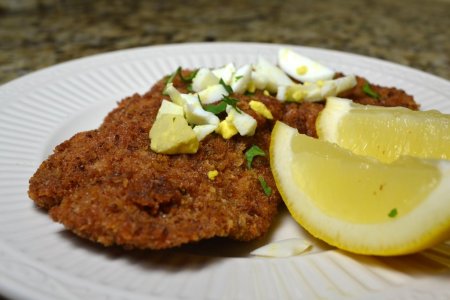Suddenly, out of the blue, the strangest thing happened. Northwest Bing Cherries went on sale for $3/lb. Having coincidentally been in Washington State, I can assure you that the idea of cherries being on any of Washington’s trees right now is crazy. Perhaps they were mislabeled and came from South America. In any case, I took the opportunity to buy some for my cherry-loving-son and baked him a Sweet Cherry Pie. Overall, my son loved the cherry pie, but otherwise it wouldn’t have been worth the $9.

December surprise (but this photo is from my prior attempt)
After several failed attempts at Chris Kimball’s “foolproof” pie dough, I finally succeeded and discovered the problem all along. It was the lack of a bench scrapper that prevented me to un-sticking the pie dough from the counter in one piece. Now I can sprinkle a little more flour underneath whenever necessary. Here is more discussion on the keys to Foolproof Pie Dough, but I won’t discuss how foolish I feel that it took me so many attempts to get this foolproof recipe right. Suffice it to say that “bench scrapper” should be on his list.
Issues:
- I used too much lemon, from 1/2 lemon, and should have measured out 1 tablespoon more closely.
- Use foil-lined baking sheet to ease clean-up. Undoubtedly, some filling will leak out onto the baking sheet.
Rating: 4 stars.
Cost: $9.
How much work? Medium.
How big of a mess? Medium/High.
Start time 11:00 AM. Dessert at 6:00 PM
Chris Kimball’s original recipe is here. The descriptions of how I prepared this today are given below:
Pie Dough:
2-1/2 cups (12-1/2 ounces) all-purpose flour
1 teaspoon salt
2 tablespoons sugar
1-1/2 sticks (12 tablespoons) cold unsalted butter
1/2 cup cold vegetable shortening
1/4 cup cold vodka
1/4 cup cold water
- Cut your butter into 1/4″ cubes, and your vegetable shortening into 4 pieces.
- Add 1-1/2 cups flour, salt, and sugar in food processor, process for two 1-second pulses until it’s just combined. Add butter cubes and shortening pieces, and process for 15-seconds until there is no un-coated flour and the dough begins to form uneven clumps ; kind of like cottage cheese curds.
- Use a rubber spatula to scrape down sides and redistribute dough evenly around processor blade. Add the final 1 cup of flour and pulse 4 to 6 times until the mixture is evenly distributed and the dough mas is broken up. Transfer the mixture to medium bowl.
- Sprinkle the cold vodka and water over mixture. Use your rubber spatula to fold and mix the dough, pressing down until slightly tacky and sticks together. Divide into 2 balls of equal size and flatten into two 4″ disk. Cover with plastic wrap and refrigerate from 1 hour.
- Remove 1 disk at a time from refrigerator and roll it out on liberally floured work surface into a 12″ circle, measuring 1/8″ thick. Use your rolling pin to lift the dough by loosely draping it around the rolling pin, then un-roll it over pie plate; leave at least 1″ overhang. Gently form the dough to plate by carefully lifting edge of dough and using your other hand to pressing the dough to the bottom of the plate. Refrigerate for 40 minutes until the dough is firm.
Cherry Filling:
2 red plums
2 pounds (6 cups) sweet cherries
1/2 cup sugar (3-1/2 ounces)
1/8 teaspoon table salt
1 tablespoon juice from 1 lemon
2 teaspoons bourbon (optional)
2 tablespoons instant tapioca
1/8 teaspoon ground cinnamon
2 tablespoons unsalted butter
1 large egg
1 teaspoon water
- Cut your plum in half and remove the pit. Remove the seeds from your cherries, and cut them in half. Use a clean coffee grinder to grind instant tapioca into a fine powder. Cut your cold butter into 1/4″ cubes.
- Place a foil-lined baking sheet on oven rack set to the lowest position, and pre-heat your oven to 400-degrees.
- Add plums halves and 1 cup of cherries to food processor and process for 1 minute until smooth. You will need to scrape down the sides of bowl once or twice. Set a fine-mesh strainer over a large bowl, pour mixture into strainer and use a rubber spatula to press down and extract as much liquid as possible, discarding the solids.
- Stir the remaining 5 cups of cherries, sugar, salt, lemon juice, bourbon (if using), powdered tapioca, and cinnamon into bowl containing the puree, and allow to stand for 15 minutes.
- Pour cherry mixture and juices into to dough-lined pie plate. Scatter 1/4″ butter cubes evenly over filling.
- Roll the second dough disk out on liberally floured work surface into a 11″ circle, measuring 1/8″ thick. Use your rolling pin to lift the dough by loosely draping it around the rolling pin, then un-roll it over pie plate; leave at least 1/2″ overhang. Use you thumb and forefinger to flute edges or you can use the tines of fork to seal the two pie crusts together.
- In a small bowl, lightly beat your egg and combine with 1 teaspoon water. Use a pastry brush to top with egg mixture. Use a sharp knife to make 8 evenly spaced 1″-long vents in top of pie; then freeze for 20 minutes.
- Transfer pie to pre-heated baking sheet and bake 30 minutes. Then reduce temperature to 350-degrees and continue to bake for another 30 minutes until the juices are bubble around the edges and crust is deeply golden brown.
- Allow pie to cool on wire rack for 3 hours before serving, so that the juices can thicken. The filling will only become firm after it has been chilled.

Sorry for the cell phone photo




 Posted by My Year With Chris Kimball
Posted by My Year With Chris Kimball 










